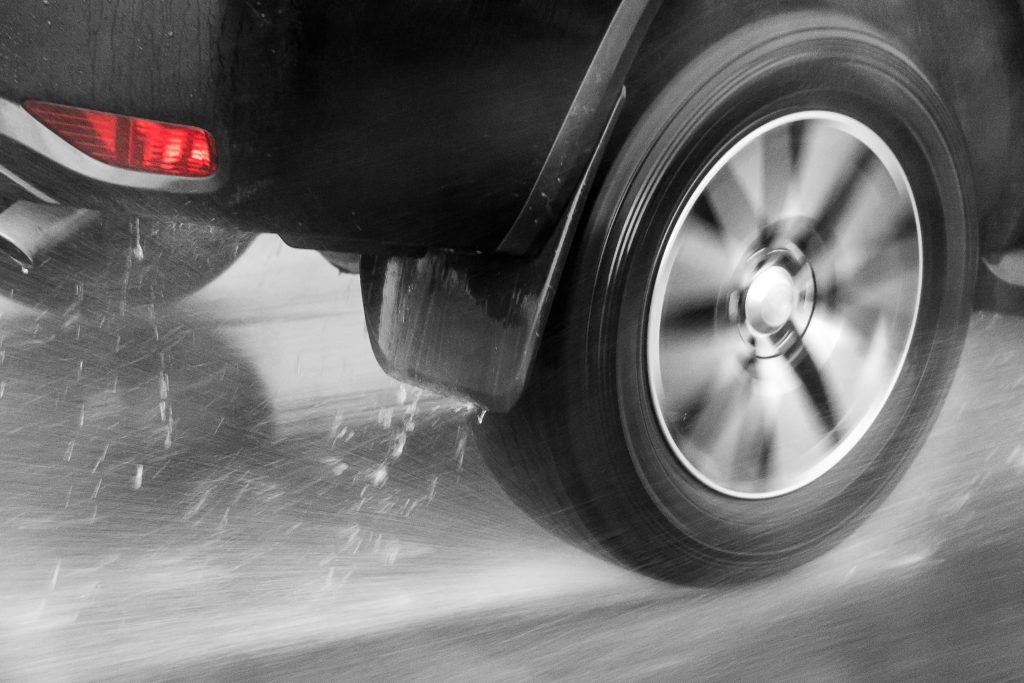
It happens before you know it
You’re driving along on an overcast day. You’re minding your speed, traffic is light, and there doesn’t seem to be anything particular to be concerned about. Suddenly it begins to rain. You know the drill: turn on your windshield wipers, make sure your headlights are on, and tap the brakes to cancel the cruise control. These are all common sense actions all drivers should take even while driving in a light rain. All of a sudden you experience a very odd sensation. Your vehicle seems to be floating above the road. You know what’s happening. It’s happened before. You’re hydroplaning. And hydroplaning can be just as dangerous as sliding across a frozen highway.
Hydroplaning usually occurs within the first 10 minutes of a rainstorm when oils, dirt and debris begin to wash off the surface of the road. It also happens when there is too much water for the tread of your tires to scatter, so your vehicle is literally lifted above the surface of the water. What do you do? Take your foot off the accelerator, don’t brake, and wait for your tires to slow down to a point where they can handle dispersing the water. Continue on at this slower speed until the storm lets up.
Your tire tread depth is critical
“Having quality tires with the proper amount of tread is one of the best things a driver can do to prevent hydroplaning,” says Robert Jordan, Assistant General Manager & Service Director at Smart Motors. “A lot of people wait until winter is approaching to change their balding tires, but we recommend you change your tires at 4/32” remaining tread, regardless of the time of year, so that you don’t experience a lag in wet weather performance.”

100-Year Flood
Hydroplaning is just one of the dangers of driving in heavy rains, as many Wisconsinites might have learned in 2018 when we experienced the “100-year flood” in which up to 20 inches of water was collected in certain areas. At Smart Motors in Madison, well over 100 flood damaged vehicles were towed in after the waters subsided to a navigable degree. Owners were hoping against hope their cars and trucks could be repaired. “Time and time again, the service department had to break the news to guests that their car or truck was totaled,” says Jordan. “In fact, the totaled vehicles far outnumbered the ones we could repair.”
Jordan says the majority of the totaled vehicles experienced water getting into the engine, which can cause irreversible damage. Jordan says, unfortunately, there is no water-depth rule. He says you don’t need to drive through a 12” puddle to cause damage. Even in shallow water, all it takes is just the right splash to find its way into the engine and ruin the vehicle.
Prevention & Common Sense Make Sense
Preventing water damage can be tricky and certainly not foolproof, but Luis Roman, Assistant Service Manager at Smart Motors says there are some measures drivers should take if there is a threat of flooding.

“First of all,” he says, “If you don’t absolutely have to drive in flood-like conditions, don’t!” Also, remember the National Weather Service trademark phrase; “Turn Around. Don’t Drown.”
If there are flood warnings, the first consideration for a driver is to move the vehicle to a higher ground if that is an option. If this is not an option, Roman says to leave the vehicle where it is.
If you are on the road during flood conditions, exercise extreme caution and a use a lot of common sense. Roman says if you can’t see the road because there’s so much standing water, don’t risk driving through it. “You can’t determine water depth without going in,” he says. “My suggestion is to pull over safely and observe other vehicles that may brave their way through the flooding.” Roman also warns during a flood, there may no longer be any roadway under the water and you could drive into an impromptu river. If the water is over 12″ in depth, it could sweep a car away.
Helpful hints for driving in rainy weather
Roman offers these additional helpful hints:
• If at all possible, wait to embark on your trip until the weather improves.
• Check your tires periodically and replace them if the tread is worn to a dangerously low level.
• Slow down
• Do not use cruise control
• Turn on your headlights. In some cases you might even want to turn on your hazards.
• Definitely use your windshield wipers. Replace them if they are damaged or worn.
• Maintain a safe distance from other vehicles.
• Avoid heavy or sudden braking.
• As mentioned above, be wary of standing water.
• If you’re hydroplaning, step off the gas and try not to brake.
• Ventilate your vehicle to prevent windows from fogging up.
About Smart Motors
Smart Motors was founded in 1908 by O.D. Smart and is one of the nation’s oldest automotive dealerships, is the mid-west’s largest hybrid dealer and one of Wisconsin’s largest volume Toyota dealers. Located at 5901 Odana Road, Smart Motors is Wisconsin’s only two-time President’s Cabinet Award recipient from Toyota Motor Sales for superior customer service & sales volume. For more information visit theircompany history.



